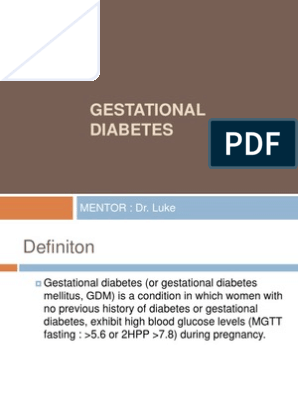0% found this document useful (0 votes)
118 views41 pagesGestational Diabetes Mellitus: Capt Narendra Sarlam MH Gwalior
This document discusses gestational diabetes mellitus (GDM), including its definition, prevalence, pathophysiology, screening and management. Some key points include:
- GDM is glucose intolerance that begins or is first diagnosed during pregnancy and resolves after delivery. It occurs in 3-18% of pregnancies.
- The placental hormones of pregnancy cause insulin resistance and directly induce hyperglycemia in the mother. The beta cells of mothers with GDM cannot compensate for this increased demand.
- Screening and treatment are recommended to reduce risks of complications for both mother and baby such as macrosomia, neonatal hypoglycemia, and cesarean delivery.
- Management involves medical nutrition therapy, exercise,
Uploaded by
yash shrivastavaCopyright
© © All Rights Reserved
We take content rights seriously. If you suspect this is your content, claim it here.
Available Formats
Download as PPT, PDF, TXT or read online on Scribd
0% found this document useful (0 votes)
118 views41 pagesGestational Diabetes Mellitus: Capt Narendra Sarlam MH Gwalior
This document discusses gestational diabetes mellitus (GDM), including its definition, prevalence, pathophysiology, screening and management. Some key points include:
- GDM is glucose intolerance that begins or is first diagnosed during pregnancy and resolves after delivery. It occurs in 3-18% of pregnancies.
- The placental hormones of pregnancy cause insulin resistance and directly induce hyperglycemia in the mother. The beta cells of mothers with GDM cannot compensate for this increased demand.
- Screening and treatment are recommended to reduce risks of complications for both mother and baby such as macrosomia, neonatal hypoglycemia, and cesarean delivery.
- Management involves medical nutrition therapy, exercise,
Uploaded by
yash shrivastavaCopyright
© © All Rights Reserved
We take content rights seriously. If you suspect this is your content, claim it here.
Available Formats
Download as PPT, PDF, TXT or read online on Scribd
/ 41






















































































